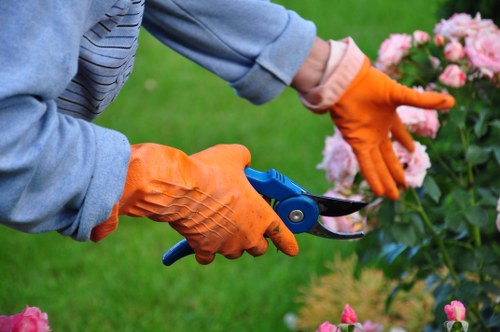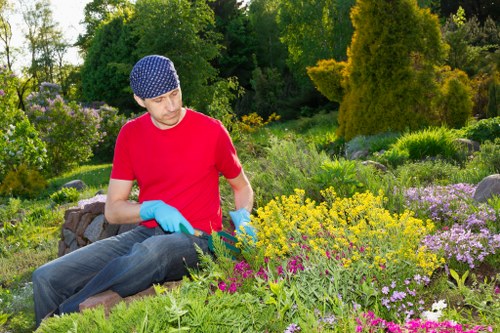Tree Lopping and Removal in Landscape Gardening
Introduction to Tree Lopping and Removal

Tree lopping and removal are essential services in landscape gardening. Whether for safety, aesthetics, or health of your garden, understanding the process can help you make informed decisions.
Lopping involves the selective cutting of specific branches, while removal refers to taking down the entire tree. Both practices require expertise to ensure minimal impact on the surrounding environment.
Proper tree management enhances the beauty and functionality of your outdoor space, contributing to the overall landscape design.
Reasons for Tree Lopping

There are several reasons to consider tree lopping:
- Health Maintenance: Removing diseased or dead branches prevents the spread of pests and diseases.
- Safety: Weak branches can pose risks during storms or high winds.
- Light Optimization: Pruning allows more sunlight to reach other plants in your garden.
Lopping should be done carefully to maintain the tree's natural shape and promote healthy growth.
A well-executed lopping process can significantly improve the longevity and appearance of your trees.
Tree Removal Process

Tree removal is a more drastic measure, typically needed when a tree is beyond saving or poses a significant threat.
The process involves:
- Assessment: Evaluating the tree's condition and the surrounding area.
- Planning: Developing a safe removal strategy.
- Execution: Carefully cutting down the tree and removing the debris.
Professional arborists use specialized equipment to ensure the removal is done safely and efficiently.
It's crucial to follow local regulations and obtain necessary permits before removing a tree.
Benefits of Professional Services

Hiring professionals for tree lopping and removal offers numerous advantages:
- Safety: Experts are trained to handle potentially hazardous situations.
- Efficiency: Professionals can complete the job quickly and correctly.
- Equipment: Access to the right tools ensures the best results.
Professional services also provide guidance on tree care, helping you maintain a healthy and attractive garden.
Investing in expert services can save you time, money, and stress in the long run.
Choosing the Right Service Provider

Selecting a reliable tree lopping and removal company is crucial for achieving desired outcomes.
Consider the following when choosing a provider:
- Experience: Look for companies with a proven track record.
- Licensing and Insurance: Ensure they are properly licensed and insured.
- Reviews and Testimonials: Check feedback from previous clients.
Additionally, inquire about their process and the equipment they use to ensure quality service.
Choosing the right provider ensures your landscape remains safe and beautiful.
Cost Factors
The cost of tree lopping and removal can vary based on several factors:
- Tree Size: Larger trees require more labor and equipment.
- Location: Trees in difficult-to-reach areas may increase costs.
- Health of the Tree: Diseased or damaged trees might need more extensive work.
Obtaining multiple quotes can help you find a service that fits your budget without compromising quality.
Investing in professional services ensures that costs are transparent and fair.
Environmental Considerations
Tree lopping and removal have environmental impacts that should be carefully managed.
Maintaining tree health contributes to biodiversity, air quality, and overall ecosystem balance.
When removal is necessary, proper disposal and, if possible, recycling of wood can minimize environmental footprint.
Safety Precautions
Safety is paramount during tree lopping and removal to protect both workers and property.
Key safety measures include:
- Using Protective Gear: Helmets, gloves, and other equipment are essential.
- Stabilizing the Tree: Ensuring the tree is secured before cutting.
- Clear Communication: Coordinating among team members to prevent accidents.
Adhering to safety protocols helps prevent injuries and property damage.
Professional arborists prioritize safety in every project they undertake.
Post-Removal Cleanup
After tree removal, thorough cleanup is necessary to restore the landscape.
Cleanup tasks include:
- Debris Removal: Clearing branches, leaves, and wood.
- Stump Grinding: Eliminating the tree stump to prevent regrowth.
- Site Restoration: Replanting or soil treatment as needed.
Proper cleanup ensures your garden remains tidy and ready for future landscaping projects.
Many service providers include cleanup in their packages for convenience.
Maintenance Tips
Regular maintenance can reduce the need for extensive tree lopping and removal.
Consider the following tips:
- Routine Inspections: Check for signs of disease or damage.
- Pruning: Regularly remove dead or overgrown branches.
- Proper Watering and Fertilization: Support tree health and resilience.
Healthy trees are less likely to require significant intervention, saving time and resources.
Employing these practices helps maintain a vibrant and sustainable garden.
Legal and Regulatory Aspects
Tree lopping and removal may be subject to local laws and regulations.
Ensure compliance by:
- Obtaining Permits: Some areas require permits for tree removal.
- Understanding Protected Species: Certain trees may be protected by law.
- Following Zoning Laws: Adhere to guidelines related to property lines and land use.
Ignoring regulations can lead to fines and legal complications.
Consulting with local authorities helps navigate the legal requirements.
Choosing the Right Tree Species
Selecting appropriate tree species can minimize future lopping and removal needs.
Consider factors such as:
- Climate Suitability: Choose trees that thrive in your local climate.
- Space Availability: Ensure adequate space for growth.
- Maintenance Requirements: Opt for species that match your willingness to perform upkeep.
Proper selection enhances the longevity and harmony of your landscape.
Consult with landscape professionals to make informed choices.
Innovative Techniques in Tree Management
Advancements in arboriculture offer new methods for effective tree lopping and removal.
Techniques include:
- Climbing Loppers: Allow precise cutting without extensive equipment.
- Aerial Lifting: Utilize cranes for hard-to-reach trees.
- Stump Grinders: Quickly eliminate stumps with minimal disruption.
These innovations improve efficiency and safety in tree management.
Staying updated with the latest techniques ensures optimal results.
Environmental Impact and Sustainability
Emphasizing sustainability in tree lopping and removal preserves natural resources.
Implement sustainable practices by:
- Recycling Wood: Use wood for mulch, compost, or other eco-friendly purposes.
- Minimizing Waste: Plan projects to reduce leftover materials.
- Promoting Biodiversity: Retain or plant diverse tree species.
Sustainable approaches contribute to a healthier ecosystem and greener landscape.
Commitment to the environment enhances the long-term beauty of your garden.
Conclusion
Tree lopping and removal are integral aspects of landscape gardening, requiring skill and knowledge.
By understanding the reasons, processes, and best practices, you can maintain a safe and beautiful outdoor space.
Whether you need selective pruning or complete tree removal, professional services offer the expertise necessary for optimal results.
Contact us today to schedule your tree lopping or removal service and enhance your landscape garden.